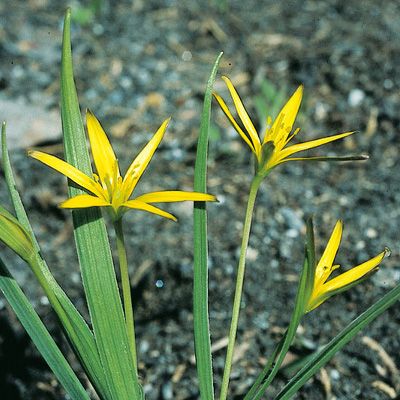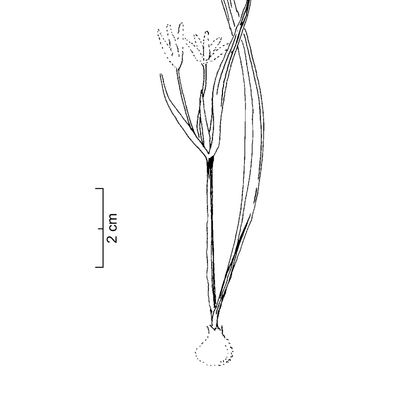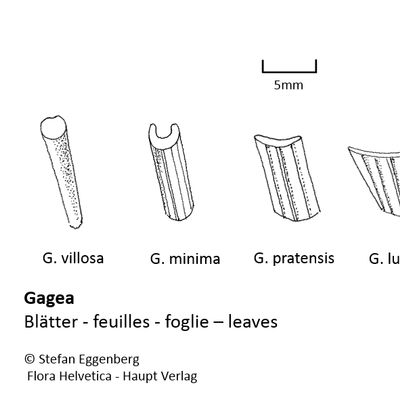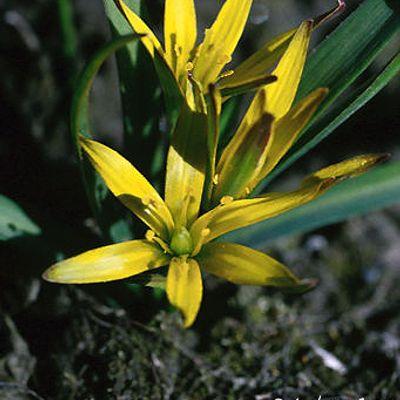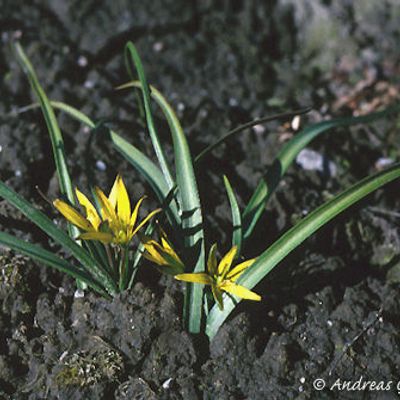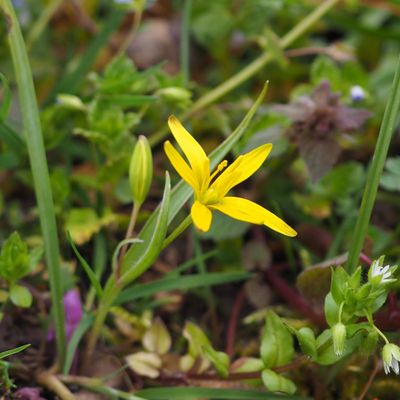Gagea pratensis (Pers.) Dumort.
1020190
Species
ISFS : 175900
Checklist : 1020190
ISFS : 175900
Checklist : 1020190
Contains :
Synthesis
Species description (© Flora Helvetica 2018)
10-15 cm hoch, meist mit einem einzigen grundständigen Blatt, dieses nur 4-6 mm breit, an der Spitze allmählich verschmälert, nicht kapuzenförmig, höchstens so breit wie das unterste Hochblatt, dieses den Blütenstand überragend. Sonst wie G. lutea (Nr. 2425).Flowering period (© Flora Helvetica 2018)
4Habitat and distribution inside Switzerland (© Flora Helvetica 2018)
Äcker, kalkhaltige Lehm- und Lössböden / kollin / GR (Rheintal), SH, ZH, AGWorld distribution (© Flora Helvetica 2018)
EuropäischEcological indicator (© Landolt & al. 2010)
2w44-44+4.g.2n=36,48,60Status
IUCN status
Critically endangeredNational Priority
2 - high national priorityInternational responsibility
1 - weakConservation
Threats
Umwandlung von Getreide- zu Maisäckern
Intensivierung der Landwirtschaft (v. a. starke Düngung und Herbizide), grosse Parzellierung
Zwiebelgeophytenfeindliche Bewirtschaftung der Rebberge: dichte Grasuntersaat, tiefe Bodenbearbeitung, häufiges Mähenund Mulchen, Herbizide schon im Frühling
Umwandlung der Hochstamm-Obstgärten
Wenige, isolierte Populationen
Distribution map
Habitat and distribution inside Switzerland
GR (Rheintal), SH, ZH, AGWorld distribution
EuropäischEcology
Life form
Geophyte
Habitats
Milieux Phytosuisse (© Prunier et al. 2017)
Habitats © Delarze & al. 2015
 | 8.2.3.2 - Kalkreicher, lehmiger Hackfruchtacker (Fumario-Euphorbion) |
bold
Dominant species, influencing the appearance of the habitat
 Character species
Character species
 Less strictly linked to a specific habitat
Less strictly linked to a specific habitat
Ecological indicator values by © Landolt & al. (2010)
| Soil factors | Climatic factors | Salinity tolerance | |||
|---|---|---|---|---|---|
| Humidity Value H | 2w | Light Value L | 4 | Salinity Index | -- |
| Reaction Value R | 4 | Temperature factor T | 4+ | ||
| Nutriments value N | 4 | Continentality K | 4 | ||
- Ecological values legend
Humidity Value H 1 very dry 1+ dry 2 moderatly dry 2+ moist 3 medium wet 3+ wet 4 very wet 4+ soggy 5 submerged or underwater f plants living in running water u mostly submerged plants v partly submerged, partly floating plants w humidity moderately variable (± scale of 1-2) w+ highly variable humidity (scale exceeding ± 2) Reaction Value R 1 Very acid (pH 2.5-5.5) 2 acid (pH 3.5-6.5) 3 lightly acid to neutral (pH 4.5-7.5) 4 neutral to basic (pH 5.5-8.5) 5 basic (pH 6-5 -> 8.5 Nutriments value N 1 very low in nutrients 2 low in nutriments 3 medium-poor to medium-rich in nutrients 4 rich in nutriments 5 very rich in nutriments Salinity tolerance 1 halotolerant 3 halophyle Light Value L 1 very shady 2 shady 3 lighted areas 4 luminous 5 highly luminous Temperature factor T 1 alpine to nival stages (from the treeline to the snowline) 1+ suprasubalpine and upper subalpine levels (pine and larch forests) 2 subalpine level (coniferous forests without beeches up to the upper limit of spruces) 2+ lower subalpine and upper mountain stages 3 mountain level (beech and silver fir forests, in the central Alps Scots pine forests) 3+ lower mountain and upper hill levels 4 hill level (mixed deciduous oak forests) 4+ hot places, hill level 5 very hot places, hill level (only in the hottest places, typical of southern Europe) Continentality K 1 Atlantic (high air humidity, very low temperature variations, mild winters) 2 Sub-Atlantic (high air humidity, low temperature variations, relatively mild winters) 3 sub-Atlantic to subcontinental (average air humidity, moderately variable temperature, slightly low winter temperatures) 4 subcontinental (low air humidity, large temperature variations, rather cold winters) 5 continental (very low air humidity, very large temperature variations, cold winters)
Water dependency
| Rivers | 0 - No link |
| Calm water | 0 - No link |
| Ground water | 0 - No link |
Nomenclature
Accepted Name (Checklist 2017)
Gagea pratensis (Pers.) Dumort.
Vernacular name
Deutscher Name :
Wiesen-GelbsternNom français :
Etoile jaune des présNome italiano :
Cipollaccio dei pratiMatch with other reference books
| Relation | Nom | Book | No |
|---|---|---|---|
| = | Gagea pratensis (Pers.) Dumort. | Checklist 2017 | 175900 |
| = | Gagea pratensis (Pers.) Dumort. | Flora Helvetica 2001 | 2854 |
| = | Gagea pratensis (Pers.) Dumort. | Flora Helvetica 2012 | 2430 |
| = | Gagea pratensis (Pers.) Dumort. | Flora Helvetica 2018 | 2430 |
| = | Gagea pratensis (Pers.) Dumort. | Index synonymique 1996 | 175900 |
| = | Gagea pratensis (Pers.) Dumort. | Landolt 1977 | 684 |
| = | Gagea pratensis (Pers.) Dumort. | Landolt 1991 | 595 |
| = | Gagea pratensis (Pers.) Dumort. | SISF/ISFS 2 | 175900 |
| = | Gagea pratensis (Pers.) Dumort. | Welten & Sutter 1982 | 2069 |
= The taxon corresponds to the accepted taxon (Checklist 2017)
< The taxon is included in the accepted taxon (Checklist 2017)
> The taxon includes (among others) also the accepted taxon (Checklist 2017)
< The taxon is included in the accepted taxon (Checklist 2017)
> The taxon includes (among others) also the accepted taxon (Checklist 2017)
Status
Native status
-IUCN list of endangered species (© Walter & Gillett 1997) : No
Status on national Red List 2016
IUCN status:
Critically endangered

Additional information
IUCN criteria: A4c
Status on regional Red List 2019
| Biogregraphic regions | Status | IUCN criteria |
|---|---|---|
| Jura (JU) | CR | A4c |
| Mittelland (MP) | CR | A4c |
| Alpennordflanke (NA) | CR | A4c |
| Alpensüdflanke (SA) | -- | |
| Östliche Zentralalpen (EA) | CR | A4c |
| Westliche Zentralalpen (WA) | -- |
- Legend
EX Extinct RE Regionally Extinct CR(PE) Critically Endangered, Probably Extinct CR Critically Endangered EN Endangered VU Vulnerable NT Near Threatened LC Least Concern DD Data Deficient NE Not Evaluated NA Not Applicable
National Priority Species List Status
| National Priority | 2 - high national priority |
| Need to take action | 2 - |
| International responsibility | 1 - weak |
| Need to monitor populations | 2 - |
Protection status
| International (Bern Convention) | No | |
| GE | total protection | (25.07.2007) |
| Switzerland | -- | |
| SH | total protection | (06.03.1979) |
- Disclaimer
InfoFlora compiles information on protected species as accurately as possible, taking it from the respective cantonal laws. In some cases, however, it was not possible to use the plant names as listed in the original text, but an interpretation of their taxonomy or nomenclature was necessary. The exact meaning of the categories „completely protected“ and „partially protected“ differs among the cantons.
InfoFlora cannot guarantee that the information on the protection status is correct and complete. In case of doubts, we recommend to look up the texts of the respective cantonal law.
Status by sector of activity
| Agriculture-related environmental objectives : | Z - | more informations |
| Forest management environmental objectives : | more informations |
Conservation
Threats and measures
Umwandlung von Getreide- zu Maisäckern
Förderung extensiver Getreideäcker (z. B. mit alten Kultursorten)
Intensivierung der Landwirtschaft (v. a. starke Düngung und Herbizide), grosse Parzellierung
Verzicht bzw. starke Reduktion von Herbizideinsatz und Düngung
kleinparzellierte Flächen beibehalten
Buntbrachen und extensive Randstreifen schaffen (Ökobeiträge)
Zwiebelgeophytenfeindliche Bewirtschaftung der Rebberge: dichte Grasuntersaat, tiefe Bodenbearbeitung, häufiges Mähenund Mulchen, Herbizide schon im Frühling
Eingriffe (auch Herbizide) nur in Ruhephase von Juni-Oktober
«unsauberes» Hacken alle 2 Jahre (offener Boden < 70%), max. 10-15 cm tief
Mähen und Mulchen max. so häufig wie für das Gedeihen der Reben unabdingbar (Integrierte Produktion oder BIO-Rebbau)
Umwandlung der Hochstamm-Obstgärten
Erhaltung und Schaffung von Hochstamm-Obstgärten
Wenige, isolierte Populationen
Schutz (Mikroreservate)
regelmässige Bestandeskontrollen
Dauerflächenbeobachtung
Ex situ-Vermehrung in Botanischen Gärten
Verstärkung von kleinen Populationen und Ansiedlung von neuen Populationen (nach Zwischenvermehrung)
Erfolgskontrolle der Massnahmen gewährleisten
